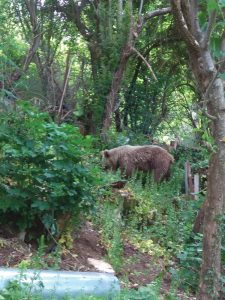Α bear cub approaching the village of Mikro Papigko in the National Park of Northern Pindos in the middle of the quarantine
For about a month now, a young bear has been moving around and inside the village of Mikro Papigko in the area of the North Pindos National Park. Recently, it has been visiting a home garden to feed on the roots of a particular plant species, without seeming to be disturbed by the presence of residents or of their dog’s. This behaviour of the animal is probably related to its young age and the relative inexperience in terms of anthropogenic dangers, but perhaps also to the new conditions that arose – even temporarily – from quarantine due to coronavirus and the reduction of human presence in the region.
The staff of the Management Agency of Northern Pindos National Park (PINDNP), has already informed the competent Forest Services about the incident, as well as the residents for the intention of its management. In particular, the possibility of conducting an operation to arrest and radiotagg the specific bear in the context of the LIFE ARCPROM Bear Emergency Team, in order to monitor its movements and take appropriate management measures to prevent it from approaching the village again.
The LIFE ARCPROM project aims to improve the coexistence of man and bear in three National Parks of Greece (Northern Pindos, Prespa, Rhodope Mountain range) and one in Italy (Majella). Partners of the project are the Management Bodies of the four National Parks, two universities (of Thessaly and Western Macedonia) and two environmental organisations (Callisto and WWF Italy). The bear approach to areas of human activity is one of the phenomena that the LIFE ARCPROM project is called upon to manage, always in collaboration with the Forest Service.
Apart from the cases that need special management by the Bear Emergency Team, human-bear interaction can be avoided by following the following general rules:
• Collection of waste from outdoor areas, squares, backyards and anything else that can be a food source for the bear.
• Avoid dumping rubbish outside the bins or at night in areas that are a habitat for the bear or where bears move, so that the bins are clean during the night.
• Repair of fences or installation of electric fences where possible, to protect agricultural and livestock capital.
• Adequate lighting around livestock facilities, villages, etc.
• Pet owners and livestock breeders should insure their animals during the night and not leave any dead animals exposed.
• Keep herds and livestock facilities guarded by shepherd dogs.
• In case of a human-bear encounter:- Do not run
- Remain motionless
-Do not make any threatening move towards the animal with any object such as stones, branches, etc.
- Gradually retreat, leaving enough space for the bear to continue its route.
For more details please visit thw project’s website http://lifearcprom.uowm.gr/
The photos were taken by Mr. Thomas Baltas, a permanent resident of Mikro Papigko, who sent them to ΡINDNP.

BET Mikro Papigko 2

BET Mikro Papigko 3






